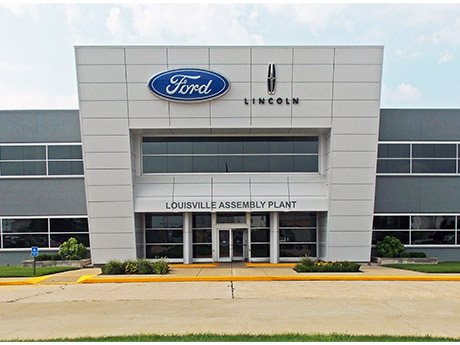Louisville’s industrial market stands out as a steady force, resisting the fluctuations often seen in surrounding Midwest cities such as Cincinnati, Columbus and St. Louis. Midyear figures show Louisville’s year-over-year rent growth exceeding the national percentage and its vacancy rate 340 basis points below the national rate, both signs of a healthy market.

Additionally, Louisville’s recognition in national trade publications and recent announcements of General Electric/Haier and Ford’s electric vehicle (EV) investment at its Louisville Assembly Plant suggests positive future job growth.
A sturdy foundation
Louisville’s centralized location has helped secure its place as a major logistical powerhouse and develop relationships with major industrial business players such as UPS, Ford and General Electric. UPS announced its first expansion into Louisville in 1981 and has continued to grow its operations since, including the recently opened $100 million automated medical labs shipping facility.
Ford also continues to invest in Louisville, recently leasing a 567,433-square-foot facility in Southern Indiana and a 426,300-square-foot facility in Louisville’s Bullitt County submarket just south of Louisville Muhammad Ali International Airport. Additionally, General Electric/Haier will move washer/dryer manufacturing processes to Louisville, creating 800 new jobs and confirming Haier’s Louisville manufacturing operations as its global hub.
A resilient market
High material costs, labor shortages, rising insurance premiums, tariffs and elevated interest rates have been topics of concern over the past several years, hindering new development as well as burdening current occupiers. While Louisville hasn’t been immune to these challenges, the economic impact has been muted compared to surrounding cities.
As of the second quarter, Louisville stands at a 3.7 percent vacancy rate, beating out the national industrial vacancy rate at 7.1 percent, as well as Cincinnati (5.8 percent), Columbus (8.2 percent), Indianapolis (10.4 percent) and Nashville (4.5 percent). Asking rent growth at the end of 2024 landed at 4.6 percent year-over-year, 200 basis points higher than the U.S. growth rate of 2.6 percent.
Year-end leasing activity and absorption figures of Louisville and five Midwest cities (Cincinnati, Columbus, Indianapolis, Nashville, and St. Louis) from 2020 to 2024 show a range of volatility, with each city at some point outperforming the others. Averages of leasing activity and absorption figures in that five-year time period, however, show that Louisville performs competitively to its bigger Midwest counterparts, with the market outperforming all but Indianapolis in absorption and leasing activity.
While the industrial real estate market faces economic headwinds, Louisville continues to showcase steady and healthy market activity that reflects continued market interest with tenant demand competing with limited speculative availability.
Inventory growth
Markets that boast about having high inventory growth numbers usually have to face the downside of large negative absorption numbers and high vacancies during dips in the economy. Louisville’s slow but deliberate inventory growth has created a buffer to the current nationwide trends of elevated vacancy rates, conservative tenant demand and slowing new construction. Limited speculative availability and shovel-ready land have kept vacancy rates low and asking rates competitive.
So far, construction completions for 2025 stand at 1 million square feet of new supply, a slower first half than anticipated. The construction pipeline at the end of the second quarter, however, tallied at 6.4 million square feet of total bulk (buildings 100,000 square feet and over) under construction. Since the end of the quarter, an additional 1.6 million square feet has started construction, totaling 8.1 million square feet of product under construction.
With an equally healthy number of planned buildings in the pipeline, the future supply for Louisville appears healthy and measured. Currently, we are still expecting new bulk deliveries to be twice the amount in 2025 compared to 2024, which will contribute to a temporary rise in the vacancy rate.
What’s next?
More and more investors and developers seem to be taking notice of Louisville’s industrial market, appreciating its stability and resistance to national economic factors. In 2025, Louisville has been named No. 9 in America’s Top States for Business (best cost of doing business) by CNBC, is No. 6 (nationally) in U.S. Metro for Economic Business by SiteSelection, and, according to NewKentuckyHomes.com, is No. 1 in vehicle production, air cargo by weight, EV battery production and bourbon exports.
Additionally, healthy leasing activity and absorption combined with a low vacancy rate and vigorous building activity suggest positive future growth.
While continued uncertainty and high construction costs may limit speculative construction, elsewhere, Louisville’s affordability, state and local incentives and convenient accessibility to over half of the U.S population in a day’s drive make the area appealing to developers and occupiers alike, ensuring a healthy future.
— By Stephan Gray, SIOR, President, Senior Director of Industrial Services, Cushman & Wakefield | Commercial Kentucky. Victoria Saunders, Research Analyst at Cushman & Wakefield | Commercial Kentucky, assisted in writing this article. This article was originally published in the September 2025 issue of Southeast Real Estate Business.


